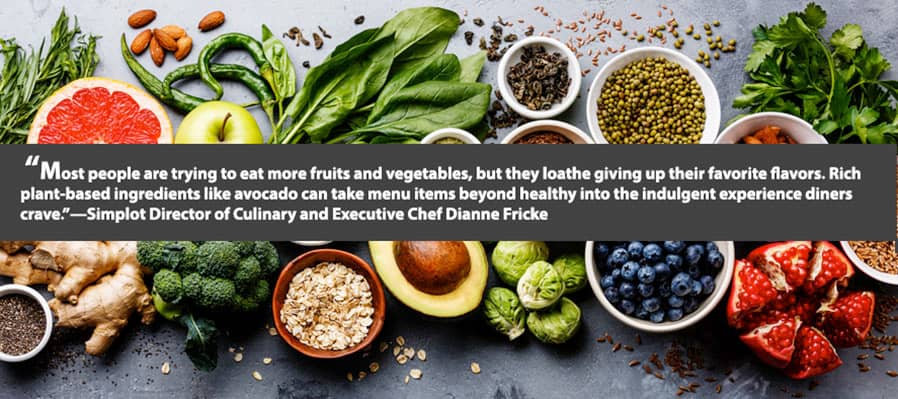Food Trends | Menu Planning
Healthy Indulgence: Catering to Patrons Who Want It All
Apr 08, 2019
As Americans, we're chock full of competing desires. We love big cars, but we want them to be fuel efficient. We want to get in shape, but exercise is hard. Food is no exception here. Americans are trying to eat more fruits and vegetables these days, but (surprise!) we're not quite ready to give up the indulgent foods we love.
- 70% of consumers are trying to increase their intake of veggies and fruits1
- 23% of consumers say they order healthier alternatives for indulgent foods at restaurants at least some of the time 2
As contradictory as these concepts may seem, it represents a sizeable opportunity for operators who can offer dishes that are both healthy and indulgent. And, with all of the creativity surrounding the preparation of vegetables and fruits these days, it's getting easier by the day.

Appeal to the health-conscious without sacrificing flavor
Even among consumers who consider themselves the healthiest, 40% said that they eat indulgent food when they're feeling down.3 After all, food choices are connected to our emotions, and healthy eaters still want to enjoy indulgent meals.
Here are some smart ways you can span the gap between healthy and indulgent for your patrons:
1. Start treating vegetables like they're meat.
Cooking techniques traditionally used on meat dishes - like marinating, roasting, and grilling, can be just as effective on their plant-based counterparts. To be successful, vegetables need to be just as crave-worthy as their meat counterparts.
2. Blur the line between vegetarian and meat-etarian.
The rise of plant-based foods shouldn't be confused with a desire to become vegetarian or vegan: the choice to go plant-based has more to do with consumers' desire to be healthy than adherence to a strict lifestyle. While some Millennials identify themselves as vegans or vegetarians, many more of them land somewhere in between. They focus on eating plant-based options as much as possible, but they don't want to be boxed in on their food choices.4 This gives you more flexibility to create delicious dishes that appeal to their flexible views on food. It doesn't have to be one or the other!
Consumers are seeking healthier alternatives to their favorite hearty, indulgent proteins like meatballs, sausage, and bacon.7 Reinventing these popular flavors and textures with vegetables will satisfy your hungry health-conscious consumers.
3. Fake it when you make it.
In typical fashion, consumers want more plant-based foods, but they love meat (in one Datassential study, 55% of consumers reported loving steak while only 5% felt that way about tofu).5
However, the innovation in meat substitutes has gone a long way in making the shift towards a plant-based center-of-the-plate possible. In fact, the top four items for plant-based alternatives are hearty indulgent proteins: burgers/sandwiches, chicken strips/wings, sausage bacon and meatballs.7 Since vegetarian dishes like the Impossible Burger have emerged, expectations for meat alternatives are high. Gone are the days of dry, sad-looking veggie burgers or fried tofu as the standard.
4. Beef up your menu descriptions.
Don't ditch the meaty vernacular in your plant-based dishes. Vegetable-centered menu items often come with unappealing labels, but it's time to rethink that. Vegetables had a higher purchasing power on test menus when operators use language that commonly describes meat dishes - think marinated cauliflower steaks, grilled Portobello burgers, and charred kale salads.6
Tips for rich, savory, and satisfying dishes, without the guilt
Rich
Use avocado or coconut milk to capture the creaminess lacking in nondairy products. Or put avocados to work as a rich egg-replacement in house-made mayonnaise. Learn more about Simplot Harvest Fresh Avocados™ products.>>
Savory
Marinate mushroom strips to develop an umami flavor, or roast cauliflower for a savory charred effect. Learn more about Simplot Simple Goodness™ vegetables.>>
Satisfying
Create moist veggie burgers with red quinoa and black beans, or try a zesty sweet potato taco complete with crunchy cabbage and bold, housemade sauces. Learn more about Simplot Good Grains™ ancient grain products.>>
Fresh vegetables aren't always the answer
While fresh produce will always be the mainstay in most kitchen, fresh has its drawbacks. The yield on fresh produce is often less than 50% after trim and spoilage. This effectively doubles their market price. Add in the cost of labor to process them and they become more expensive.
Frozen products like Simplot Simple Goodness™ vegetables and Simplot Harvest Fresh Avocados™ deliver tremendous color, flavor and texture without all the labor, waste and dangerous knife work. They're also available year-round.
The best of both worlds
Whether consumers label themselves vegetarian, pescatarian, vegan-ish, or are just aspiring healthy eaters, they really just want nutritious food that tastes good. Serve up the best of both worlds with tasty vegetables and plant-based alternatives they can't turn down—and watch your sales go up!
1 Datassential
2 Technomic, Healthy Eating Consumer Trend Report, 2016
3 Foodmix Marketing Communications Study, 2016
4 T. Colin Campbell Center for Nutrition Studies, 2016
5 Datassential, 2018
6 Plant Based Food Innovation Summit, 2018
7 Datassential MenuTrends, 2018


